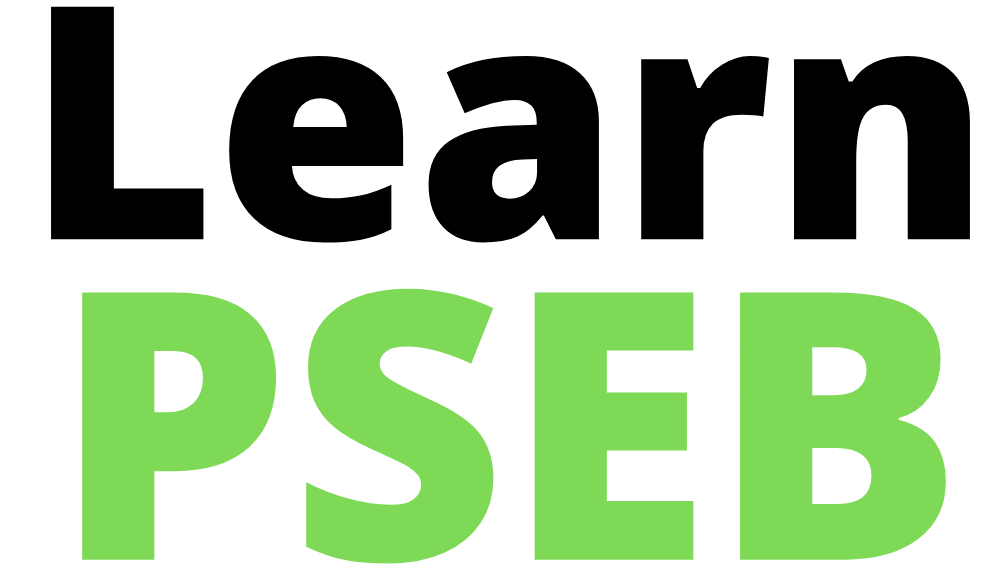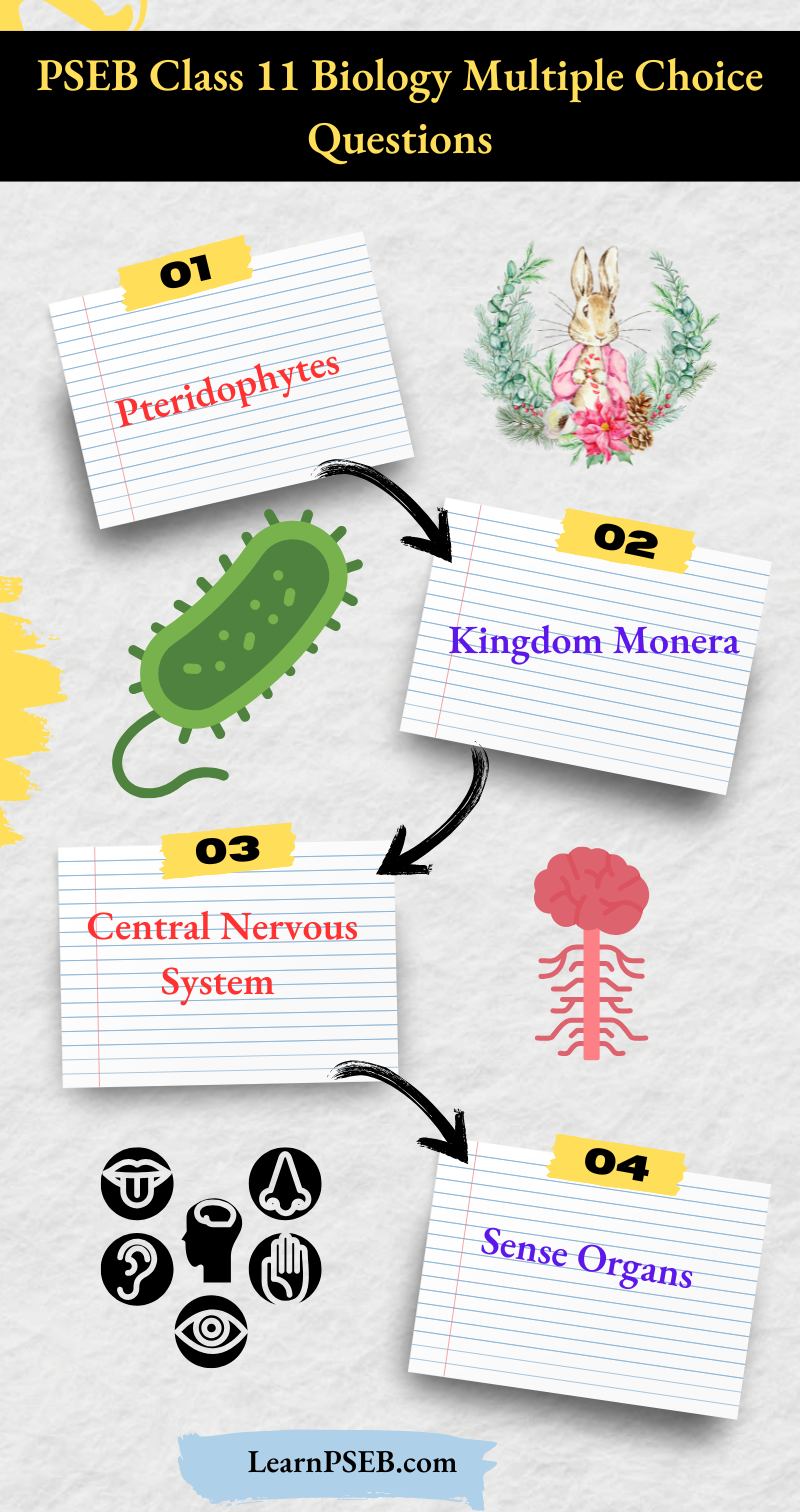
Class 11 Biology
PSEB 11th Class Biology Kingdom Monera Multiple Choice Questions
Kingdom Monera Multiple Choice Questions
Question 1. From competitive examinations
Find out the comet match:
- Aids- bacillus anthesis
- Syphilis- treponema pallidum
- Gonorrhea- Leishmania donovani
- Urethritis- enthameaobea gingivalis
Answer: 2. Aids- bacillus anthesis
Question 2. Bt gene occurs in
- Bacillius thurigensis
- Escherichia coli
- Agrobacterium tumefaciens
- Rhixobium leguminosarum
Answer: 1. Bacillius thurigensis
Question 3. In which bacterial reproduction phage lake part?
- Conjugation
- Transformation
- Binary fission
- Transduction.
Answer: 4. Transduction.
Read And Learn More Class 11 Biology MCQs
Question 4. Mvcoplasmas arc not sensitive to :
- Penicillin
- Streptomycin
- Erythromycin
- Neomycin.
Answer: 1. Penicillin
PSEB 11th Class Biology Kingdom Monera MCQs
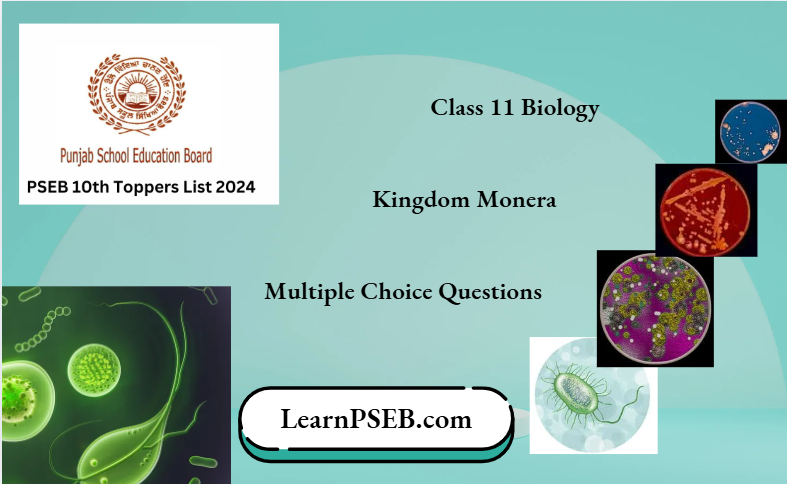
Question 5. Mitotic apparatus is absent in:
- Green algae
- Fungi
- Bacteria
- Higher plants.
Answer: 3. Bacteria
Question 6. Teichoic acid is present in the cell wall of:
- Bacteriophage
- Mycoplasma
- Nostoc
- Pneumococcus.
Answer: 4. Pneumococcus.
Question 7. Disease pneumonia is due to:
- Virus
- Bacterium
- Cyanobacterium
- Protozoan.
Answer: 2. Bacterium
Question 8. Bacteria cannot survive in highly salted pickles because:
- Bacteria do not get light for photosynthesis
- The pickle does not contain nutrients necessary for bacteria to live
- Salt inhibits reproduction
- Bacteria get plasmolysed and thus killed.
Answer: 4. Bacteria get plasmolysed and thus killed.
Question 9. A non-legume, symbiotic nitrogen-fixing bacterium is:
- Rhizobium
- Azotobacter
- Frankia
- Clostridium.
Answer: 3. Frankia
Question 10. What is true for photolithotrophs?
- Obtain energy from radiations and hydrogen from organic compounds
- Obtain energy from radiations and hydrogen from inorganic compounds
- Obtain energy from organic compounds
- Obtain energy from inorganic compounds.
Answer: 2. Obtain energy from radiations and hydrogen from inorganic compounds
Question 11. The difference in gram + ve and gram – ve bacteria is due to:
- Cell wall
- Cell membrane
- Ribosome
- Cytoplasm.
Answer: 1. Cell wall
Question 12. What is true for archaebacteria?
- All halophiles
- All photosynthetic
- All fossils
- Oldest living beings
Answer: 4. Oldest living beings
Question 13. Which of the following is not produced by in the lactose medium?
- Thiognlnclosidc transacetylase
- Lactose dehydrogenase
- Lactose permease
- I-galactosidase.
Answer: 2. Lactose dehydrogenase
Kingdom Monera Multiple Choice Questions PSEB Class 11
Question 14. The cell wall of a bacterium is composed of:
- Cellulose
- Chitinous
- Cellulose
- Chitin
- Mureill.
Answer: 4. Mureill.
Question 15. Plasmids occur in-
- Chromosomes
- Viruses
- Bacteria
- Chloroplasts.
Answer: 3. Bacteria
Question 18. Milk is changed into curd by:
- Acetobacter acetic
- Bailius megatherium
- Xanthomonas citri
- None.
Answer: 4. None.
Question 19. Match the names of antibiotics listed under column 1 with their sources given under column 2. Select the correct alphabet of two columns:
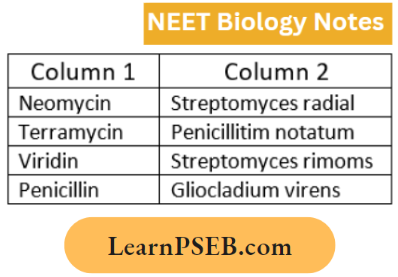
- A—p, b—r, c—s, d—q
- A—r, b—p, c—s, d—q
- A—s, b—p, c—r, d—q
- A—r, b—s, c—p, d—q.
Answer: 4. A—r, b—s, c—p, d—q.
Question 17. Which one of the following organisms may respire in the absence of oxygen?
- Azotobacter
- Clostridium
- Rhizobium
- Lactobacillus.
Answer: 2. Clostridium
Question 18. Milk is changed into cured by
- Acetobacter aceti
- Bacillus megatherium
- Xanthomonas citri
- None.
Answer: 4. None.
Kingdom Monera Multiple Choice Questions PSEB Class 11
Question 19. Bacteria prepare food by oxidation of:
- N2
- N03
- Oxygen
- Glycogen.
Answer: 4. Glycogen.
Question 20. Extrachromosomal material of bacteria is found in:
- Circular dna
- Extrachromosomal dna
- Chromosomal dna
- Plasmid.
Answer: 4. Plasmid.
Question 23. Which of the following is correct?
- Diatoms produce basodiopores
- Hererocycytes occur in Boston
- Fronds develop in bryophtes
- Multiciliates sperms occur in angiosperms
Answer: 2. Hererocycytes occur in Boston
Question 24. Mnrein does not occur in the wall of :
- Diatoms
- Nostoc
- Eubacteria
- Blue-green algae.
Answer: 1. Diatoms
Question 25. Bacterial flagella are made up of
- Chlorine
- Fluorine
- Iodine
- Bromine.
Answer: 1. Chlorine
Question 26. Bacterial flagella are made up of :
- Protein
- Amines
- Lipids
- Carbohydrates.
Answer: 1. Protein
Question 27. Bacterium pseudomonas is useful as it can :
- Transfer genes from one plant to another
- Fix atmospheric nitrogen
- Produce several antibiotics
- Decompose a variety of organic compounds.
Answer: 2. Fix atmospheric nitrogen
Question 28. Bacterial ribosomes are :
- 70S
- 60 S
- 80 S
- 50 S.
Answer: 1. 70S
Question 29. The iron-chelating substance is produced by a growth-promoting rhizobacterium:
- Rhizobium japonicum
- Azospirillium
- Pseudomonas putida
- Aspergillus.
Answer: 2. Azospirillium
PSEB Class 11 Biology Chapter Kingdom Monera MCQs
Question 30. Which one is not correctly matched :
- Streptomyces—antibiotic
- Serratia—drug addiction
- Rhizobium—biofertilizer
- Spirulina—single cell protein.
Answer: 2. Serratia—drug addiction
Question 31. Azolla has a symbiotic relationship with :
- Chlorella
- Anabaena
- Nostoc
- Tolypothrix.
Answer: 2. Anabaena
Question 32. The best well-studied batching-plant relationship is that of:
- Cymmbactcrinl symbiosis with some aquatic ferns
- Modulation in snbanla stem
- Tiall formation by ay, what Merriam
- Growth stimulation by phosphate bacteria.
Answer: 3. Tiall formation by ay, what Merriam
Question 33. Auxosporcs and oocysts are formed respectively by
- Several diatoms and a few cyanobacteria
- Several cyanobacteria and several diatoms
- Some diatoms and several cyanobacteria
- Some cyanobacteria and many diatoms.
Answer: 1. Several diatoms and a few cyanobacteria
Question 34. Barophilic prokaryotes:
- Grow slowly in highly alkaline frozen lakes at high altitudes
- Occur in water containing high concentrations of barium hydroxide
- Grow and multiply in very deep marine sediments
- Readily grow and divide in seawater enriched in any soluble salt of barium.
Answer: 1. Grow slowly in highly alkaline frozen lakes at high altitudes
Question 35. For retting of jute, the fermenting microbe used is:
- Helicobacter pylori
- Mesophilic bacteria
- Streptococcus lactis
- Butyric acid bacteria.
Answer: 4. Butyric acid bacteria.
Question 36. Gram-ve bacteria possess peptidoglycan and an extra layer of:
- Protein
- Lipoprotein
- Lipopolysaccharide
- Lipid.
Answer: 3. Lipopolysaccharide
PSEB Class 11 Biology Chapter Kingdom Monera MCQs
Question 37. Which of the following is a pathogenic bacterium of the colon
- Balantidium coli
- Entamoeba coli
- Enterobium vermicularis
- Escherichia coli.
Answer: 4. Escherichia coli.
Question 38. Nitrogen-fixing bacteria are associated with
- Malvaceae
- Gramineae
- Cruciferae
- Leguminasae
Answer: 4. Leguminasae
Question 39. Which of the following contain polyhedral bodies?
- Bacteria
- Nostoc
- Mycoplasma
- None of the above.
Answer: 2. Nostoc
Question 40. Inoculation against malaria is out of the question because:
- It does not produce antibodies and antitoxins
- Plasmodium produce antitoxins
- Plasmodium produces minute bodies
- None of the above.
Answer: 1. It does not produce antibodies and antitoxins
Question 41. Bacteria are considered plants because they :
- Have chlorophyll
- Have stomata
- Have rigid cell walls that are green in color
Answer: 3. Have rigid cell walls that are green in color
Question 42. Curing olten leaves is brought about by the activity of:
- Viruses
- Fungi
- Bacteria
- Myconhizn
Answer: 3. Bacteria
Question 43. In prokaryotes. Chromatophotvs atv
- Specialized granules responsible for the coloration of cells
- Structure is responsible for organizing the shape of (be organism
- Inclusion bodies lying five inside the cells for carrying out various metabolic activities
- Internal membrane systems that may become extensive and complex in photosynthetic bacteria
Answer: 4. Internal membrane systems that may become extensive and complex in photosynthctic bacteria.
Question 44. Which of the following is a flowering plant with modules containing filamentous nitrogen-fixing microorganisms?
- Crotalaria juncea
- Cycos revoluta
- Ciccr arietinwn
- Casuarina equisetifolia.
Answer: 4. Casuarina equisetifolia.
Question 45. Which one of the following statements is correct?
- Both azotobacter and rhizobium fix atmospheric nitrogen in root nodules of plants.
- Cyanobacteria such as anabasine and nostoc are important mobilizers of phosphates and potassium for plant nutrition in the soil.
- At present it is not possible to grow maize without chemical fertilizers.
- Extensive use of chemical fertilizers may lead to eutrophication of nearby water bodies.
Answer: 4. Extensive use of chemical fertilizers may lead to eutrophication of nearby water bodies.
Question 46. Which one of the following statements about mycoplasma is wrong?
- They are pleomorphic
- They are sensitive to penicillin
- They cause diseases in plants
- They are also called people.
Answer: 2. They are sensitive to penicillin
Question 47. Which one of the following is an example of a negative feedback loop in humans
- Secretion of tears alters the falling of sand particles into the eye.
- Salivation of the mouth at the sight of delicious food.
- Secretion of sweat glands and constriction of skin blood vessels when it is too hot.
- Constriction of skin blood vessels and contraction of skeletal muscles when it is too cold.
Answer: 4. Constriction of skin blood vessels and contraction of skeletal muscles when it is too cold.
PSEB Class 11 Biology Chapter Kingdom Monera MCQs
Question 48. In the light of recent classification of living organisms into three domains of life (bacteria, archaea, and eukarya), which one of the following statements is true about archaea?
- Archaca completely differs from both prokaryotes and eukaryotes
- Archaea completely differ from prokaryotes
- Archaea resemble eukarya in all respects
- Archaea have some novel features that are absent in other prokaryotes and eukaryotes.
Answer: 4. Archaea have some novel features that are absent in other prokaryotes and eukaryotes.
Question 49. Organisms called methanogens are most abundant in a :
- Sulfur rock
- Cattle yard
- Polluted stream
- Hot spring.
Answer: 2. Cattle yard
Question 50. Besides paddy fields, cyanobacteria are also found inside the vegetative part of :
- Cycas
- Equisetum
- Psilotum
- Pinus
Answer: 1. Cycas
Question 51. Which of the following are likely to be present in deep sea water?
- Eubacteria
- Blue-green algae
- Saprophytic fungi
- Archaebacteria
Answer: 4. Archaebacteria
PSEB Class 11 Biology Sense Organs Multiple Choice Question and Answers
Sense Organs Multiple Choice Question and Answers
Question 1. Taste Buds Of The Interior Stile Of Longue In Humans Can Detect:
- Sour Taste
- Bitter Taste
- Sweet Taste
- Saltish Taste.
Answer: 2.
Question 2. Anterior Irregular Wavy Part Of the Retina Is :
- Ora Serrata
- Pars Optica
- Ocular Conjunctiva
- Fovea Centralis.
Answer: 1.
Question 3. Structure That Provides Balance To The Body Is Located In
- Outer Ear
- Middle Ear
- Inner Ear
- Eustachian Tubes.
Answer: 3. Inner Ear
Question 4. When We Migrate From Dark To Light, We Fail To See For Some Time, But After A Time Visibility Becomes Normal. It Is an Example Of the:
- Accommodation
- Adaptation
- Mutation
- Photoperiodism.
Answer: 2. Adaptation
Read And Learn More Class 11 Biology MCQs
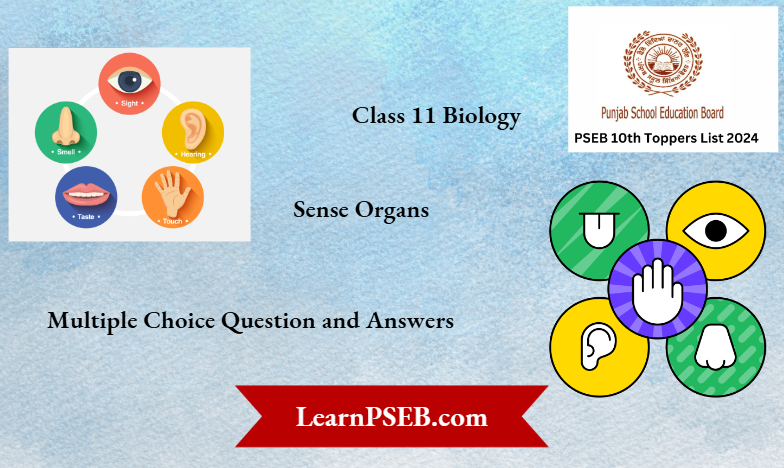
Question 5. Characteristic Character Of Human Comea :
- Secreted By Conjunctiva And Glandular
- It Is Lacrimal Gland that secretes Tears
- Blood Circulation Is Absent In Cornea
- In Old Age, It Becomes Hardened And White Layer Deposits On It Which Causes The Cataract.
Answer: 3. Blood Circulation Is Absent In Cornea
Question 6. The Arrangement Of Ear Ossicles In Mammalian Ear Is
- Stapes, Malleus, Incus
- Malleus, Incus, Stapes
- Incus, Malleus, Stapes
- Columella, Malleus, Incus.
Answer: 2. Malleus, Incus, Stapes
PSEB Class 11 Biology Sense Organs MCQs
Question 7. Opacity Of The Lens In The Eyes Leads To :
- Cataract
- Presbyopia
- Astigmatism
- Hyperopia.
Answer: 1. Cataract
Question 8. The Thinnest Skin Is Present On The :
- Eyelids
- Soles Of Feet
- Back Of The Hand
- Forehead.
Answer: 1. Eyelids
Question 9. Which Of The Following Cranial Nerves accepts information From the Corlis Organ?
- Auditory
- Vagus
- Oculomotor
- Trigeminal.
Answer: 1. Auditory
Question 10. Meissner Corpuscles Are Responsible For :
- Heat And Present In Skin
- Cold And Present In Skin
- Pressure And Present In Skin
- Pain And Present In Skin.
Answer: 3. Pressure And Present In Skin
Question 11. The Animals Who Can See Well At Night Have Abundant In Their Eyes.
- Cone Cells
- Scotopic Pigments
- Rod Cells
- Vision Cell.
Answer: 3. Rod Cells
Question 12. Excess Or Less Of Air Pressure In the Car Is Balanced By :
- Custiichinn Tube
- Car Ossicles
- Car Muscles
- Ear Pinna.
Answer: 1. Custiichinn Tube
PSEB Class 11 Biology Chapter Sense Organs MCQs
Question 13. The Receptors Found In The Muscles, Tendons And Joints Are :
- Teloreceptors
- Proprioceptors
- Intcroccptors
- Thermoreceptors.
Answer: 2. Proprioceptors
Question 14. When The Intensity Of Light Is Low During Night The Light Is Detected By :
- Rods
- Cones
- Lens
- Both 1 And 2.
Answer: 1. Rods
Question 15. Which Of The Following Is Concerned With Static Equilibrium?
- Semicircular Canals And Cochlea
- Semicircular Canals And Utricle
- Lagena And Sacculus
- Otolith And Lagena.
Answer: 2. Semicircular Canals And Utricle
Question 16. Ommatidia Serve The Purpose Of Photoreception In :
- Frog
- Sunflower
- Cockroach
- Human.
Answer: 3. Cockroach
PSEB Class 11 Biology Sense Organs MCQs
Question 17. Human Ear Is Equipped To Register Sounds Of Frequencies Per Second Between :
- 20-20000 Cycles
- 1000-2000 Cycles
- 5000-7000 Cycles
- 5000-10000 Cycles.
Answer: 1. 20-20000 Cycles
Question 18. Retina Is Similar To Which Part Of Camera?
- Lens
- Film
- Flash
- Shutter.
Answer: 2. Film
Question 19. Sensory Cells For Picking Up Sound Vibrations Are Present In :
- Utriculus
- Cochlea
- Sacculus
- Semicircular Canal.
Answer: 2. Cochlea
Question 20. Circular Ciliary Muscles Of the Eye Are Unable To Contract. It Will Result In :
- Impairment Of Vision
- Making Lens More Convex
- Making Lens Thin And Stretched
- No Effect Of Bright Light On Retina.
Answer: 3. Making Lens Thin And Stretched
Question 21. The Point In the eyeball from Which the Optic Nerve And Blood Vessels Leave Is :
- Pass Optica
- Pupil
- Blind Spot
- Yellow Spot.
Answer: 3. Blind Spot
Question 22. In A Man, Abducens Nerve Is Injured. Which One Of The Following Functions Will Be Affected?
- Movement Of The Eye Ball
- Swallowing
- Movement Of The Longue
- Movement Of The Neck
Answer: 1. Movement Of The Eye Ball
Question 23. Internal Ear Is Filled With
- Perilymph
- Endolymph
- Lymph
- Both 1 And 2
Answer: 2. Endolymph
Question 24. Rods And Cones Of Eye Are Modified:
- Multipolar Neuron
- Unipolar Neuron
- Bipolar Neuron
- None Of These.
Answer: 2. Unipolar Neuron
Question 25. Sense Of Smell Is Perceived By :
- Pituitary
- Hypothalamus
- Olfactory Lobe
- Cerebrum.
Answer: 3. Olfactory Lobe
Sense Organs Multiple Choice Questions PSEB Class 11
Question 26. Ora Sonata Is :
- Gland Present In The Oral Cavity Of Frog
- A Part Of The Third Wall Of the Retina Of the Eye
- Present In Utriculus Of Ear
- Oral Cavity Of Protochordates
Answer: 2. A Part Of the Third Wall Of the Retina Of the Eye
Question 27. Adaptation Of Eyes In Dark Is Due To :
- Depletion Of Vision Pigment In Rods
- Depletion Of Vision Pigment In Cones
- Repletion Of Vision Pigment In Rods
- Repletion Of Vision Pigment In Cones.
Answer: 3. Repletion Of Vision Pigment In Rods
Question 28. Feelings Of Anger, Pain And Pleasure Are Experienced Through :
- Limbic System
- Frontal Lobe
- Parietal Lobe
- Reticular System.
Answer: 1. Limbic System
Question 29. In Which Of Following Only Cone Cells Are Found?
- Fovea Centralis
- Retina
- Fossa ovalis
- Blind Spots.
Answer: 1. Fovea Centralis
Question 30. Bowman’s Glands Are Found In :
- External Autjitary Canal
- Cortical Nephrons Only
- Juxtamedu]Lpy Nephrons
- Olfactory Epithelium.
Answer: 4. Olfactory Epithelium.
Question 31. Identity’ The Correct Sequence Of Organs/Regions In The Organization Of Human Ear As An Auditory MechanoReceptor Organ :
- Pinna-Cochlea-Tympanic Membrane-Audiory Canal-Malleus-Stapes-Incus-Auditory Nerve
- Pinna-Auditory Canal-Tympanic Membrane- Malleus-Incus-Stapes-Cochlea-Auditory Nerve
- Pinna-Tympanic Membrane-Auditory Canal-Incus- Malleus-Stapes-Cochlea-Auditory Nerve
- Pinna-Tympanic Membrane-Auditory Canal- Cochls-Malleus-Lncus-Stapes-Auditory Nerve.
- Pinna-Malleus-Incus-Stapes-Auditory Canal- Tympanic Membrane-Cochlea-Auditory Nerve.
Answer: 2. Pinna-Auditory Canal-Tympanic Membrane- Malleus-Incus-Stapes-Cochlea-Auditory Nerve
Question 32. Muller’s Cells Occur In :
- Heart
- Retina
- Kidney
- Pancreas.
Answer: 2. Retina
Sense Organs Multiple Choice Questions PSEB Class 11
Question 33. Jacobson’s Otguns Which Arc Additional Olfactory Organs Ate Present In :
- Rat
- Man
- Snake
- All Of These.
Answer: 3. Snake
Question 34. Given Below Is A Diagrammatic Cross Section Of A Single Limp Of Human Cochlea Which One Of The Following Options Correctly Re-Presents The Names Of Three Different Parts?
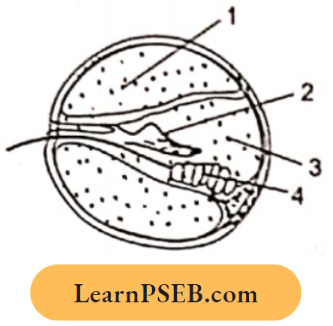
- 4: Sensory Hair Cells, 2: Endolymph 2: Tectorial Membrane 4 Semom Air Cell
- 1: Perilymph, 2 Tectorial Membrane 3: Endolymph 4. Secretory Hair Cells
- 2: Tectorial Membrane, 3: Parilymph, 4 Secretory Cells
- 3: Endolymph, 5: Sensory Hair Cells, 1: Serum.
Answer: 2. 1: Perilymph, 2 Tectorial Membrane 3: Endolymph 4. Secretory Hair Cells
Question 35. Fovea In The Eye Is A Central Pit In The Yellowish Pigmented Spot Called
- Blind Spot
- Retina
- Cornea
- Macula Lutea
- Choroid.
Answer: 4. Choroid.
Question 36. The Purplish Red Pigment Rhodopsin Contained In The Rods Type Of Photoreceptor Cells Of The Human Eye, Is A Derivative Of :
- Vitamin B,
- Vitamin C
- Vitamin D
- Vitamin A
Answer: 4. Vitamin A
PSEB Class 11 Biology Chapter Sense Organs MCQs
Question 37. Parts A, B, C And D Of The Human Eye Are Shown In The Diagram. Select The Option Which Gives Correct Identification Along With Its Functions/Characteristics :
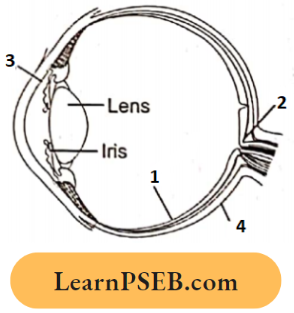
- 2-Blind Spot-Has Only A Few Rods And Cones.
- 3-Aqueous Chamber- Reflects The Light Which Does Not Pass Through The Lens.
- 4-Choroid- The Anterior Part Forms the Ciliary Body.
- 1-Retina – Contains Photoreceptors – Rods And Cones.
Answer: 4. A-Retina – Contains Photoreceptors – Rods And Cones.
PSEB Class 11 Biology On Central Nervous System Multiple Choice Questions
PSEB Class 11 Biology On Central Nervous System Multiple Choice Questions
Question 1. During the Development Of Action Potential In A Nerve Fibre, Positive And Nfor Exampleative Charges On the Outer And Inner sides of the Axon Membrane Are Reversed Due To :
- Exteusion Of All K+ Ions
- More K+ Ions Enter Than Na+ Ions Leave The Axon
- More Na+ Ions Enter The Axon Than K+ Ions Leave The Same
- All Na+ Ions Enter The Axon.
Answer: 3. More Na+ Ions Enter The Axon Than K+ Ions Leave The Same
Question 2. Broca Area And Wernicke Centre Of Association Area Occur In Cerebrum. They Are Connected With :
- Memory
- Voluntary Action
- Blind Spot
- Both 1 And 2.
Answer: 4. Blind Spot
Question 3. Centre Of Thirst And Hunger Is Located In :
- Cerebrum
- Cerebellum
- Hypothalamus
- Medulla Oblongata.
Answer: 3. Hypothalamus
Read And Learn More Class 11 Biology MCQs
Question 4. Common Feature Amongst Acetylcholine, Noradrenaline And Serotonin Is :
- All Are Anticoagulants
- They Lower Blood Pressure
- They Raise Heart Beat
- All Are Neurotransmitters.
Answer: 4. All Are Neurotransmitters.
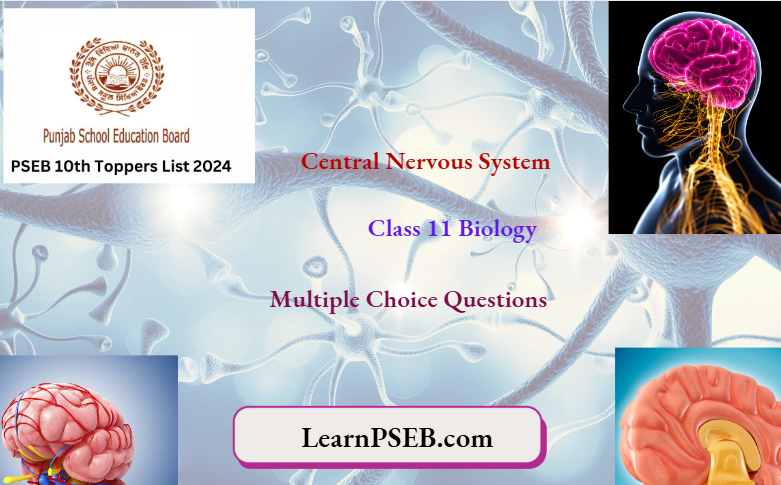
Question 5. At the Resting Stage Nerve Cell Have:
- Low K+ Outside And High Na+ Inside
- High K+ Inside And High Na+ Outside
- High K+ Inside And Low Na+ Outside.
- High K+ Outside And Low Na+ Inside
Answer: 2. High K+ Inside And High Na+ Outside
Question 6. Nerve Axon Takes Part In :
- Receiving Impulse
- Transformation Of Energy
- Conducting Of Impulse
- Providing Energy For Impulse Transmission.
Answer: 3. Conducting Of Impulse
Question 7. Venom Of Cobra Affects:
- Respiratory System
- Nervous System
- Circulatory System
- Digestive System.
Answer: 2. Nervous System
Question 8. Refractory Period Is During :
- Depolarization
- Repolarization
- Polarization
- Both 1 And 2.
Answer: 4. Both 1 And 2.
PSEB Class 11 Biology Central Nervous System MCQs
Question 9. Node Of Ranvier Is The Place Where :
- Myelm Sheath Is Discontinuous
- Myelin Sheath And Neurilemma Are Discontinuous
- Axolemma Is Absent
- Axolemma Is Discontinuous.
Answer: 1. Myelm Sheath Is Discontinuous
Question 10. In The Diagram Of the Section Of the Brain Given Below, Different Parts Are Indicated By Alphabet. Choose The Answer In Which These Alphabets Have Been Correctly Matched With The Parts These Indicate :
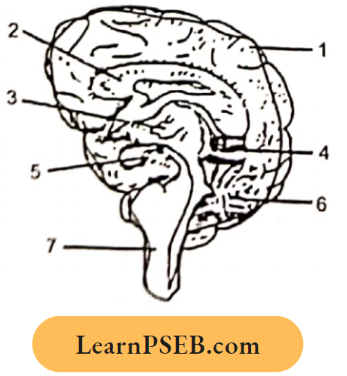
- 1 = Cerebral Hemisphere, 2 = Corpus Callosum, 3 = Thalamus, 4 = Pineal Gland, 5 = Cerebellum, 6 = Pituitary, 7 = Medulla Oblongata.
- 1 = Cerebral Hemisphere, 2 = Thalamus, 3 = Corpus Callosum, 4 = Pineal Gland, 5 = Pituitary, 6 = Medulla Oblongata, 7 = Cerebellum.
- 1 = Corpus Callosum, 2 = Cerebral Hemisphere, 3 = Pituitary, 4 = Pineal Gland, 5 = Thalamus.
- 1 = Cerebral Hemisphere, 2 = Corpus Callosum, 3 = Thalamus, 4 = Pineal Gland, 5 =Pituitary, 6 = Cerebellum, 7 = Medulla Oblongata.
Answer: 4. 1 = Cerebral Hemisphere, 2 = Corpus Callosum, 3 = Thalamus, 4 = Pineal Gland, 5 =Pituitary, 6 = Cerebellum, 7 = Medulla Oblongata.
Question 11. In The Diagram Of T.S. Of The Spinal Cord Given Below, Certain Parts Have Been Indicated By Alphabet. Choose The Answer In Which These Alphabets Have Been Correctly Matched With The Parts Of Which They Indicate :
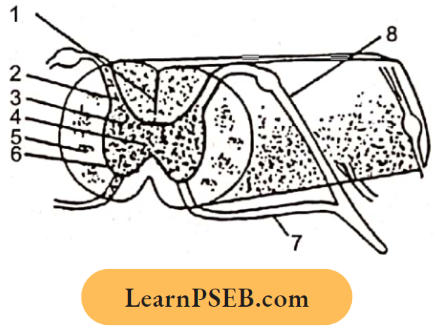
- L = Dorsal Septum, 2 = Dorsal Horn, 3 S Grey Matter, 4 = Central Cavity, 5 = White Matter, 6 =Ventral Hom, 7 = Ventral Root, 8 = Dorsal Root And Ganglion ,
- 1 = Dorsal Septum, 2 = Dorsal Hom, 3 = Central Cavity, 4 Grey Matter, 5 = Ventral Hom, 6 =White Matter, 7 = Dorsal Root And Ganglion,
- 1 = Dorsal Septum, 2i Dorsal Hom, 3 = Grey Matter, 4 =White Matter, 5 = Central Cavity, 6 =Ventral Root, 7 = Dorsal Root And Ganglion
- 1 = Dorsal Septum, 2 = Dorsal Hom, 3 = Central Cavity, 4 =Grey Matter, 5 = Ventral Hom, 6 =White Matter, 7 = Dorsal Root And Ganglion 8 = Ventral Root ‘
Answer: 1. L = Dorsal Septum, 2 = Dorsal Horn, 3 S Grey Matter, 4 = Central Cavity, 5 = White Matter, 6 =Ventral Hom, 7 = Ventral Root, 8 = Dorsal Root And Ganglion
Question 12. Which Of The Following Cranial Nerve Controls The Movement Of Eye Ball?
- Oculomotor
- Optic
- Ophthalmic
- Trochlear.
Answer: 1. Oculomotor
Question 13. Which Of The Following Is a part Of the Human Brain?
- Corpora Bigemina
- Corpora Allata
- Corpora Adiposa 1
- Corpora Quadrigemina.
Answer: 4. Corpora Quadrigemina
Question 14. A Bipolar Neuron Has :
- Two Dendrites And One Oxon
- One Oxon And One Dendrite
- Two Axons And One Dendrite
- Two Axons And Two Dendrites.
Answer: 2. One Oxon And One Dendrite
Question 15. These Processes Occur During Repolarization Of Nerve Fibre :
A. Open Na+ Channel
B. Close Na+ Channel
C. Close K+ Channel
D. Open K+ Channel.
- B And C
- A And C
- B And D
- A And B.
Answer: 3. B And D
Question 16. Which Of the following Ctamal Naves Are Mixed :
A. Vagus
B. Trigeminal
C. Glosxopbanngeal
D. Amhtoiy.
Answer Codes :
- A, B, And C Are Correct
- B And D Are Correct
- A And C Are Correct
- A And B Are Correct.
Answer: 1. A, B, And C Are Correct
PSEB Class 11 Biology Central Nervous System MCQs
Question 17. Touch On The Right Side Stimulate Neurons On :
- Right Somatic Sensory Area
- Right Somatic Motor Area
- Left Somatic Sensory Area
- Both 1 And 3
Answer: 3. Left Somatic Sensory Area
Question 18. Respiratory Centre Of Brain Is Sensitised By :
- More Blood To Brain
- More Blood In The Lungs
- More Co2 Cone, In The Blood
- More O2 Cone, In The Blood.
Answer: 3. More Co2 Cone, In The Blood
Question 19. The Point In Eye Of Mammals From Which Optic Nerves And Blood Vessels Leaves The Eye Ball Is :
- Yellow Spot
- Blind Spot
- Pars Optica
- None Of These.
Answer: 2. Blind Spot
Question 20. The Primary Visual Area Is Located In :
- Frontal Lobe
- Parietal Lobe
- Temporal Lobe
- Occipital Lobe.
Answer: 4. Occipital Lobe
Question 21. Choroid Plexus Is A Network Of :
- Nerves
- Lymph Vessels
- Capillaries
- Muscle Fibres.
Answer: 3. Capillaries
Question 22. In The Resting State Of The Neural Membrane, Diffusion Due To Concentration Gradients, If Allowed, Would Drive :
- K+ Into The Cell
- K+ And Na+ Out Of The Cell
- Na+ Into The Cell
- Na+ Out Of The Cell.
Answer: 3. Na+ Into The Cell
Question 23. Injury To Vagus Nerve In Humans Is Not Likely To Affect:
- Tongue Movements
- Gastrointestinal Movements
- Pancreatic Secretion
- Cardiac Movements.
Answer: 1. Tongue Movements
Question 24. Unidirectional Transmission Of A Nerve Impulse Through Nerve Fibre Is Because:
- Nerve Fibre Is Insulated By A Medullary Sheath
- Sodium Pump Starts Operating Only At The Cyton And Then Continues Into The Nerve Fibre
- Neurotransmitters Are Released By Dendrites And Not By Axon Endings
- Neurotransmitters Are Released By The Axon Endings And Not By Dendrites.
Answer: 4. Neurotransmitters Are Released By The Axon Endings And Not By Dendrites.
Question 25. Which Of The Following Is Mixed Nerve?
- Glossopharyngeal
- Trochlear
- Hypoglossal
- Oculomotor.
Answer: 1. Glossopharyngeal
Question 26. Four Healthy People In Their Twenties Got Involved In Injuries Resulting In Damage And Death Of A Few Cells Of The Following. Which Of The Cells Are Least Likely To Be Replaced By New Cells?
- Ostcocyles
- Malpighian Layer Of The Skin
- Liver Cells
- Neurons.
Answer: 4. Neurons
Question 27. One Of The example of The Action Of The Autonomous Nervous System Is :
- Knee-Jerk Response
- Pupillary Reflex
- Swallowing Of Inod
- Peristalsis Of The Intestines.
Answer: 4. Peristalsis Of The Intestines.
Central Nervous System Multiple Choice Questions PSEB Class 11
Question 28. Parkinson’s Disease (Characterized By Tremors And Progressive Rigidity Of Limbs) Is Caused By the degeneration Of Brain Neurons That Are Involved In Movement Control And Make Use Of Neurotransmitters:
- Acetylcholine
- Norepinephrine
- Dopamine
- Gaba
Answer: 3. Dopamine
Question 29. In A Man, Abducens Nerve Is Injured. Which One Of The Following Functions Will Be Affected?
- Movement Of The Eye Ball
- Movement Of The Tongue
- Swallowing
- Movement Of The Neck.
Answer: 1. Movement Of The Eye Ball
Question 30. You Are Watching A Horror Movie And You Notice Your Heart Is Beating Fast And Mouth Is Dry. It Is Because Of
- Fight And Flight Response
- Sympathetic Nervous System
- Parasympathetic Nervous System
- Both 1 And 3
Answer: 4. Both 1 And 3
Question 31. Reflex Action Is Controlled By :
- Sympathetic Nervous System
- Automatic Nervous System
- Spinal Cord
- Craniosacral Outflow.
Answer: 3. Spinal Cord
Question 32. Tree Of Life Is :
- Arbor Vitae
- Pons Varolii
- Organ Of Corti
- Diencephalon.
Answer: 1. Arbor Vitae
Question 33. Arbor Vitae Is Part Of:
- Cerebrum
- Cerebellum
- Mid Brain
- Fore Brain.
Answer: 2. Cerebellum
Question 34. Which Has H – H-Shaped Grey Matter?
- Cerebrum
- Medulla Oblongata
- Cerebellum
- Spinal Cord
Answer: 4. Spinal Cord
Central Nervous System Multiple Choice Questions PSEB Class 11
Question 35. Find Out The Correct Answer From The Following Statements. The Main Functions Of The Cerebrum Of the Human Brain Are
A. To Control The Contraction Of Voluntary Muscles Through The Frontal Lobe
B. To Control The Sensitivity, Movement, Memory, Vocabulary Etc. Through The Frontal Lobe
C. To Control The Temperature, Taste, Touch, Pain Etc, Through The Parietal Lobe
D. To Control The Vision And Adaptation Through The Occipital And Frontal Lobes.
Choose The Correct Answer.
- A, B, D
- C, D, A
- A, B, C
- B, C, D.
Answer: 1. A, B, D
Question 36. A Diagram Showing the Axon Terminal And Synapse Is Given. Identify Correctly At Least Two Of A-D.
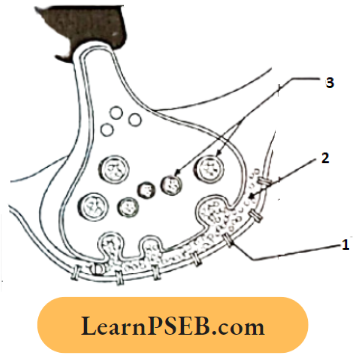
- B – Synaptic Connection D – K+
- C – Neurtransmitter D – Ca++
- A – Neurotransmitter B – Synaptic Cleft
- A – Receptor C – Synaptic Vesicles.
Answer: 4. A – Receptor C – Synaptic Vesicles.
Question 37. In Parasympathetic Nervous System Which Of The Following Is Released?
- Epinephrine
- Nor Epinephrine
- Serotonin
- Acetylcholine.
Answer: 4. Acetylcholine.
Question 38. Column I Lists The Parts Of The Human Brain And Column Ii Lists The Functions. Match The Two Columns And Identify The Correct Choice From Those Given.
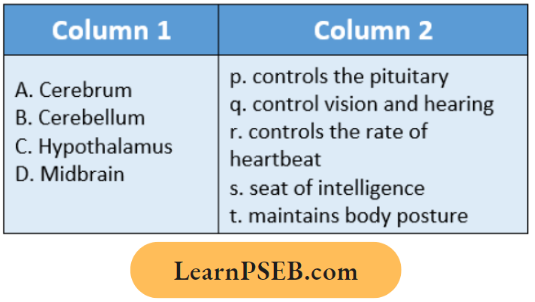
- A = T; B = S ; C = Q ; D = P
- A = S ; B = T C = R D = P
- A = T; B = S ; C = R ; D = Q
- A = S, B = T; C = P, D = Q.
Answer: 4. A = S , B = T; C = P , D = Q.
Question 39. Hypothalamus Does Not Control :
- Hunger And Satiety
- Thermoregulation
- Creative Thinking And Consciousness
- Osmoregulation.
Answer: 3. Creative Thinking And Consciousness
PSEB Class 11 Biology Chapter CNS MCQs
Question 40. Match The Following Human Spinal Nerves In Column 1 With The Number Of Pairs In Column 2 and Choose The Correct Options.
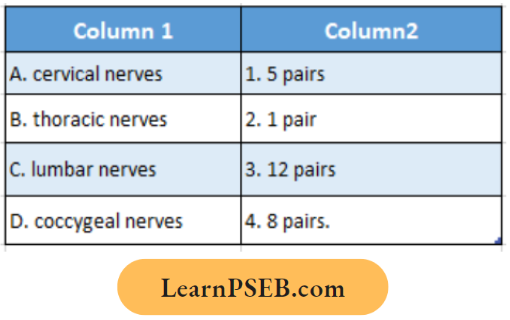
- A – 2, B – 4, C – L, D-3
- A – A, B – 3, C – 1 D -2
- A – 3, B – 3 C – 2, D- A
- A – 4, B – 1, C – 2, D – 3.
Answer: 2. A – A, B – 3, C – 1 D -2
Question 41. The Brachial Plexus Are Formed By These Spinal Nerves:
- IV, V, Vi Cervical
- V, Vi, Vii, Viii Cervical And Thoracic
- IV To Vh Lumbar
- First Three Sacral.
Answer: 2. V, Vi, Vii, Viii Cervical And Thoracic
Question 42. Which One Of The Following Does Not Act As A Neurotransmitter?
- Epinephrine
- Norepinephrine
- Cortisone
- Acetylcholine.
Answer: 3. Cortisone
Question 43. In The Given Diagram Which Stage Of Conduction Of Nerve Impulse Through Nerve Fibre Is Observed?
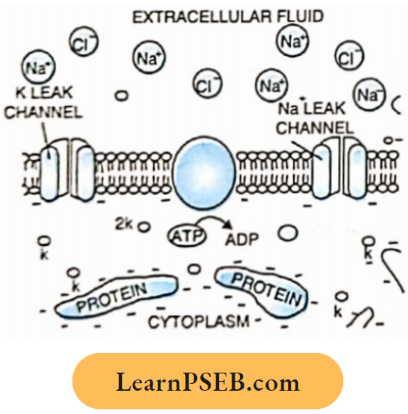
- Polarization
- Resting Potential
- Repolarization
- Depolarization.
Answer: 2. Resting Potential
Question 44. How Many Pairs Of Spinal Nerves Are Found In Humans?
- 32
- 31
- 30
- 33.
Answer: 2. 31
Question 45. The Decoding And Interpretation Of Visual Information Is Carried Out By Which Part Of The Brain?
- Cerebellum
- Frontal Lobe
- Parietal Lobe
- Temporal Lobe
- Occipital Lobe.
Answer: 3. Temporal Lobe
Question 46. Match The Entries In Column I With Those In Column Ii And Choose The Correct Combination From The Options Given.
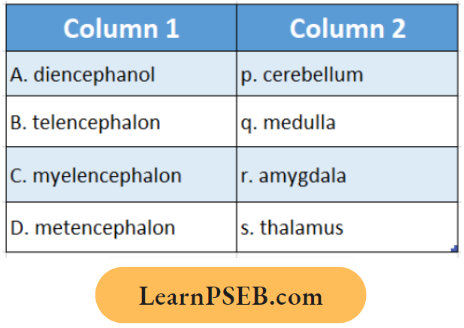
- A-4, B-3, C-L, D-2
- A-3, B-4, C-1 D-2
- A-4, B-1, C-2, D-3
- A-1, B-2, C-3, D-A
- A-4, B-1, C-2, D-3.
Answer: 3. A-4, B-1, C-2, D-3
Question 47. The Accumulation Of Protein Called Amyloid 3 Peptide In the Human Brain Causes :
- Addison’s Disease
- Huntington’s Disease
- Alzheimer’s Disease
- Motor-Neuron Disease
- Parkinson’s Disease.
Answer: 3. Alzheimer’s Disease
PSEB Class 11 Biology Chapter CNS MCQs
Question 48. A Typical Value Of Resting Membrane Potential Is :
- – 40 Mv
- – 60 Mv
- – 70 Mv
- – 80 Mv
- – 90 Mv.
Answer: 2. – 60 Mv
Question 49. Given Below Is A Table Comparing The Effects Of Sympathetic And Parasympathetic Nervous System For Four Features (1-4). Which One Feature Is Correctly Described?
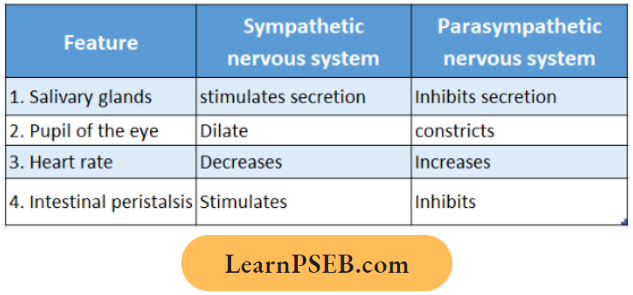
Answer: 2. Pupil Of The Eye – Dilate – Constricts
Question 50. Bowman’s Glands Are Located In The :
- Anterior Pituitary
- Female Reproductive System Of Cockroach
- Olfactory Epithelium Of Our Nose
- Proximal End Of Uriniferous Tubules.
Answer: 3. Olfactory Epithelium Of Our Nose
Question 51. During The Transmission Of Nerve Impulse Through A Nerve Fibre, The Potential On The Inner Side Of The Plasma Membrane Has Which Type Of Electric Charge?
- First Positive, Then Negative, And Continue To Be Negative
- First Negative, Theh ‘Positive And Continue To Be Positive
- First Positive, Then Negative, And Again Back To Positive
- First Negative, Then Positive, And Again Back To Negative
Answer: 4. First Negative, Then Positive, And Again Back To Negative
Question 52. During The Propagation Of A Nerve Impulse, The Action Potential Results From The Movement Of :
- K+ Ions From Intracellular Fluid To Extracellular Fluid
- Na+ Ions From Extracellular Fluid To Intracellular Fluid
- K+ Ions From Extracellular Fluid To Extracellular Fluid
- Na+ Ions From Intracellular Fluid To Extracellular Fluid.
Answer: 2. Na+ Ions From Extracellular Fluid To Intracellular Fluid
Question 53. The Potential Maintained Across The Neuron Membrane During The Resting State Is :
- + 70 Mv
- – 70 Mv
- 0.5 V
- – 30 Mv
- + 30 Mv
Answer: 2. – 70 Mv
Question 54. A Person Entering An Empty Room Suddenly Finds A Snake Right In Front On Opening The Door. Which One Of The Following Is Likely To Happen In His Neuro-Hormonal Control System?
- Neurotransmitters Diffuse Rapidly Across The Cleft And Transmit A Nerve Impulse.
- The Hypothalamus Activates The Parasympathetic Division Of the Brain.
- The sympathetic Nervous System Is Activated Releasing Epinephrine And Norepinephrine From the Adrenal Cortex.
- The sympathetic Nervous System Is Activated Releasing Epinephrine And Norepinephrine From Adrenal Medulla.
Answer: 4. The Sympathetic Nervous System Is Activated Releasing Epinephrine And Norepinephrine From the Adrenal Medulla.
Question 55. The Human Hind Brain Comprises Three Parts, One Of Which Is :
- Corpus Callosum
- Cerebellum
- Hypothalamus
- Spinal Cord.
Answer: 2. Cerebellum
MCQs On Pteridophytes Class 11 Biology
Question 1. The rudimentary seed habit has been attained in :
- Psilotum
- Lycopodium
- Selaginella
- Equisetum.
Answer: 3. Selaginella
Question 2. Which of the following plants exhibit independent alternation of generations?
- Angiosperms
- Gymnosperms
- Pteridophytes
- Bryophytes.
Answer: 3. Pteridophytes
Question 3. Seed habit first originated in:
- Certain ferns
- Certain pines
- Certain monocots
- Primitive dicots.
Answer: 1. Certain ferns
Read And Learn More Class 11 Biology MCQs
Question 4. What may be the possible advantage accruing out of the presence of antheridia and archegonia on the underside of a fern prothallus?
- They are protected from the direct rays of the sun.
- Capillary water accumulates on the underside of the prothallus between its lower surface and the soil surface. Sex organs projecting in this water can be readily fertilized by the ciliated sperms which are chemotactically attracted by the archegonia.
- The sex organs are protected from wind.
- Nutrients manufactured by the green prothallus can
readily seep downwards to the sex organs due to the action of gravity.
Answer: 2. Capillary water accumulates on the underside of the prothallus between its lower surface and the soil surface. Sex organs projecting in this water can be readily fertilized by the ciliated sperms which are chemotactically attracted by the archegonia.
Question 5. In selaginella:
- Gametophyte is dominant
- Sporophyte is dominant
- Sporophyte is total parasite
- Gametophyte is a total parasite.
Answer: 2. Sporophyte is dominant
MCQs on Pteridophytes Class 11 Biology
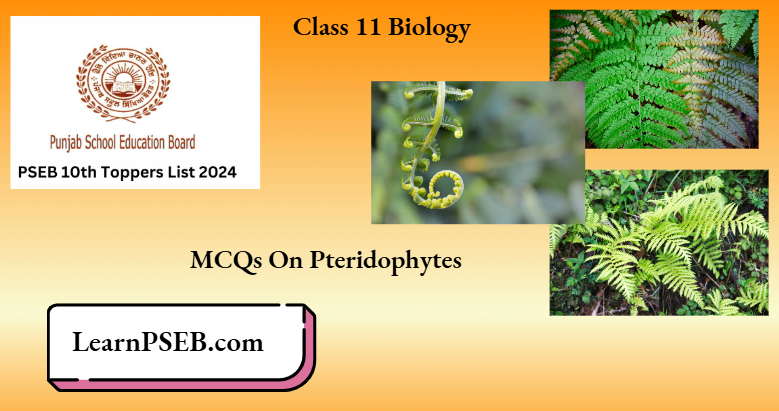
Question 6. Fern gametophyte bears:
- Roots
- Antheridia
- Archegonia
- Both 2 and 3.
Answer: 2. Antheridia
Question 7. In selaginella, the male gametes are :
- Uniflagellate
- Biflagellate
- Non-flagellate
- Multiflagellate.
Answer: 2. Biflagellate
Question 8. The term prothallus is used for :
- Stage before thallus
- Plant body without differentiation of stem, leaves, and roots
- Reduced gametophyte
- Reduced sporophyte.
Answer: 3. Reduced gametophyte
Question 9. A plant having vascular supply, producing spores, and lacking seeds is:
- Bryophyte
- Pteridophyte
- Angiosperm
- Gymnosperm.
Answer: 2. Pteridophyte
Question 10. Meiosis occurs in ferns during:
- Spore formation
- Archegonia formation
- Antheridia formation
- Both 2 and 3.
Answer: 1. Spore formation
Question 11. Annulus occurs in :
- Annual plants
- Mosses
- Gymnosperms.
- Both mosses and ferns
Answer: 3. Gymnosperms.
Pteridophytes MCQs for Class 11 with Answers
Question 12. Selaginella multiplies vegetatively through :
- Tubers
- Resting buds
- Fragmentation
- All the above.
Answer: 4. All the above.
Question 13. Which aquatic fern performs nitrogen fixation?
- Azolla
- Nostoc
- Salvia
- Salvinia.
Answer: 1. Azolla
Question 14. Ferns are the first to appear after a forest fire because of the survival of their:
- Spores
- Fronds
- Rhizome
- Both 2 and 3.
Answer: 3. Rhizome
Question 15. Which one propagates through the leaf tip :
- Marchantia
- Moss
- Walking fern
- Pinus.
Answer: 3. Walking fern
Question 16. Meiosis occurs in pteridophytes during :
- Gamete formation
- Spore formation
- Postgamete formation
- Postspore formation.
Answer: 2. Spore formation
Question 17. Ectophloic siphonostele is found in :
- Adiantum and cucurbitaceae
- Osmunda and equisetum
- Marsilea and botrychium
- Dicksonia and maidenhair fern.
Answer: 2. Osmunda and equisetum
Question 18. Which is the resurrection plant?
- Dryopteris fillixmass
- Adiantum caudatum
- Adiantum capillusveneris
- Selaginella lepidophylla.
Answer: 4. Selaginella lepidophylla.
Class 11 Biology Chapter Pteridophytes MCQs
Question 19. Which one of the following is called maidenhair fern?
- Dryopteris
- Pteris
- Adiantum
- Lycopodium
- Selaginella.
Answer: 3. Lycopodium
Question 20. Which one of the following is heterosporous?
- Adiantum
- Equisetum
- Dryopteris
- Salvinia.
Answer: 4. Salvinia.
Question 21. Compared with the gametophytes of the bryophytes, the gametophytes of vascular plants tend to be :
- Smaller but to have larger sex organs
- Larger but to have smaller sex organs
- Larger and to have larger sex organs
- Smaller and to have smaller sex organs.
Answer: 4. Smaller and to have smaller sex organs.
Question 22. The heterosporous pteridophyte belonging to the class lycopsids is
- Selaginella
- Psilotum
- Equisetum
- Pteris
- Adiantum
Answer: 1. Selaginella
